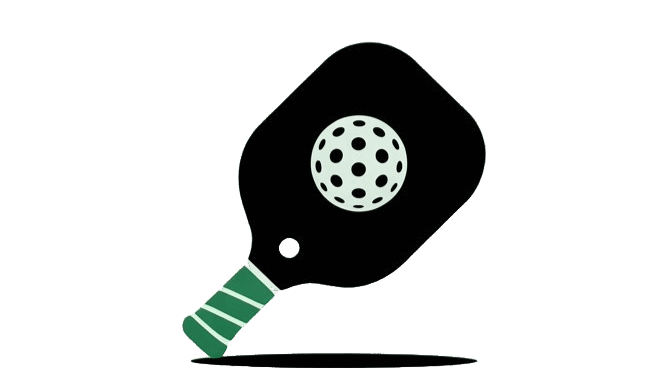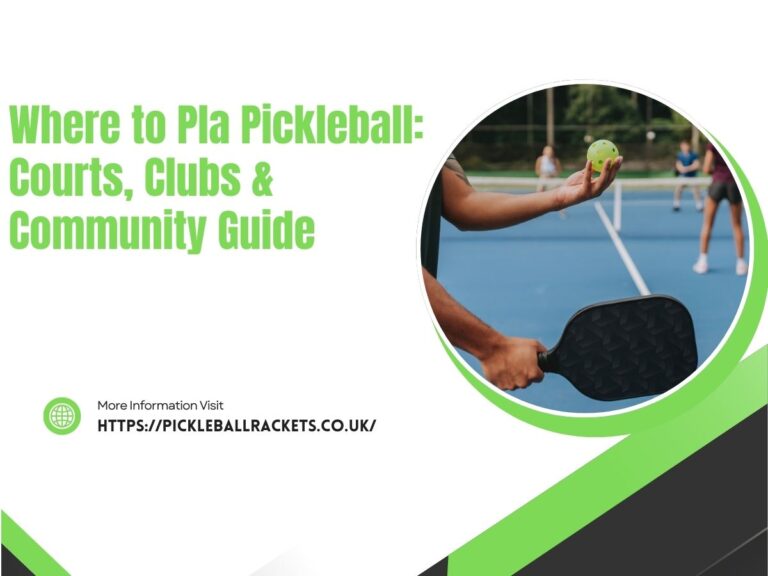Pickleball has exploded in popularity, moving from a backyard pastime to a globally recognized sport with a vibrant professional circuit. As more players join the fun, a common question arises: “How good am I?” This is where pickleball ratings and rankings come in. They provide a standardized way to measure skill, ensure fair matches, and track progress for players at all levels.
Understanding this system is your gateway to a more rewarding pickleball experience, whether your goal is to win a local tournament or simply enjoy more competitive recreational games.
This guide will explain everything you need to know about the pickleball rating system, the professional scene, player earnings, and even how to organize your own tournament. We will cover the what, why, and how of DUPR, UTPR, pro tours, and much more.
What Is a Pickleball Rating?
A pickleball rating is a numerical representation of a player’s skill level. The primary purpose of a rating is to create fair and competitive matchups. When players of similar skill levels compete against each other, games are more enjoyable and challenging for everyone involved. Without a rating system, a complete beginner could be pitted against a seasoned tournament player, leading to a frustrating and lopsided experience.
Ratings serve several key functions:
- Fair Competition: They group players into skill brackets for leagues, ladders, and tournaments, ensuring you play against others at a comparable level.
- Skill Assessment: A rating gives you an objective measure of your current ability and helps you identify areas for improvement.
- Tracking Progress: As you play and improve, your rating will change, providing tangible evidence of your development in the sport.
While several rating systems exist, they all generally operate on a scale from beginner (around 2.0) to professional (5.5+). The higher the number, the more advanced the player.

What Is DUPR in Pickleball?
One of the most talked-about systems is DUPR, which stands for Dynamic Universal Pickleball Rating. Launched in 2021, DUPR has quickly become the most widely adopted global rating system for pickleball. Its goal is to be the single, most accurate and reliable measure of a player’s skill, regardless of their age, gender, location, or whether they play recreationally or in tournaments.
How DUPR Calculates Ratings
The magic of DUPR lies in its sophisticated algorithm. Here’s a breakdown of how the pickleball DUPR is explained and calculated:
Results-Based: Your DUPR is based solely on the results of your matches. It doesn’t matter who you are, only how you perform on the court.
Points Exchanged: When a match is logged, the winning players take points from the losing players. The number of points exchanged depends on the ratings of all four players and the probability of the outcome. An upset (lower-rated players beating higher-rated players) results in a larger point transfer than an expected win.
Connectivity: Your rating is connected to everyone you play with and against. This creates a vast, interconnected web of players. If you beat someone who recently beat a high-level player, your rating will reflect that strength of schedule, even if you never played the high-level player yourself.
Rec and Tournament Play: DUPR counts all types of matches—recreational, league, and tournament. This makes it inclusive for every type of player.
The Benefits of DUPR
DUPR offers several advantages over older, more traditional rating systems:
- Universality: It aims to rate every player on the same scale, creating a global standard.
- Accuracy: By considering the margin of victory (for tournament play) and the ratings of all players involved, it provides a highly nuanced assessment of skill.
- Inclusivity: Both recreational and competitive players can get and maintain a DUPR, bridging the gap between casual and serious play.
- Dynamic Nature: Your rating updates after every logged match, providing a real-time reflection of your current form.
Other Rating Systems
While DUPR is gaining dominance, it’s not the only system you’ll encounter. Understanding the others provides a complete picture of the pickleball rating landscape.
UTPR (USA Pickleball Tournament Player Ratings)
Before DUPR, the UTPR (formerly just UTPR, now often referred to as the USA Pickleball rating) was the standard for tournament players in the United States. It’s the official rating system of USA Pickleball, the national governing body for the sport.
Here’s how UTPR differs from DUPR:
- Tournament-Only: UTPR is calculated exclusively from results in USA Pickleball-sanctioned tournaments. Recreational or league matches do not count.
- Slower Updates: The rating algorithm is run periodically, not after every match, so updates are less frequent.
- Four-Digit Rating: UTPR is a four-digit number (e.g., 4.127), whereas DUPR uses two decimal places (e.g., 4.13). The concepts are similar, but the presentation is different.
The main debate of DUPR vs UTPR pickleball centers on inclusivity versus specificity. UTPR is a proven, reliable system for dedicated tournament players, while DUPR’s strength is its ability to rate the entire pickleball population.
Self-Ratings and Club Ratings
For many players, especially beginners, the first encounter with a rating is a self-assessment. Many local clubs, community centers, and online groups use a simple 2.0 to 5.0 scale to organize open play sessions. Players are asked to rate themselves based on skill-level descriptions.
For example:
- 2.0-2.5: A beginner who is learning the basic rules and can sustain short rallies.
- 3.0: Can hit serves, returns, and dinks with some consistency but lacks control.
- 3.5: Has improved shot consistency and understands basic strategy.
- 4.0: Consistently hits shots with control and depth; understands advanced strategy.
- 4.5+: Controls the game, has mastered all shot types, and makes very few unforced errors.
While helpful for organizing local play, self-ratings are subjective and can be inaccurate. They serve as a good starting point before a player establishes an official DUPR or UTPR.
Pickleball Rating System in the UK and Europe
Outside the US, the pickleball rating system is less fragmented. DUPR is rapidly becoming the de facto standard across the UK and Europe. National governing bodies like Pickleball England have officially adopted DUPR as their rating system. This simplifies things for players, as they can use a single rating for local play, national tournaments, and even international events.
How to Get a Pickleball Rating
Getting your first pickleball rating is straightforward. The path depends on whether you’re a casual player or aiming for competitive tournament play.
For Beginners and Recreational Players
If you’re new to the sport, don’t worry about a rating immediately. Focus on learning the rules, developing your skills, and having fun. Once you’re ready to see where you stand, follow these steps:
Download the DUPR App: Create a free account on the DUPR website or mobile app.
Play with Others Who Have a DUPR: The easiest way to get rated is to play a match with or against players who already have an established DUPR.
Log Your Match: After the game, any player from the match can log the score in the DUPR app. They will tag the other three players and enter the final score.
Validate the Score: The other players in the match will receive a notification to validate the score. Once one player from the opposing team confirms it, the match becomes official.
Get Your Rating: After your first official match is logged, the DUPR algorithm will generate your provisional rating. After a handful of matches (5-10), your rating will become more stable and accurate.
For Competitive and Tournament Players
If you plan to play in sanctioned tournaments, your rating journey will be slightly different, though it now heavily involves DUPR as well.
Play in a DUPR-Certified Event: Many major tournaments run by the PPA Tour, APP Tour, and MLP now use DUPR. Simply by participating, your results will be automatically uploaded to your DUPR profile.
Play in USA Pickleball Tournaments: To get a UTPR, you must become a member of USA Pickleball and compete in one of their sanctioned events. Your results will be used to calculate your initial UTPR.
Keep Playing: Both systems reward activity. The more you play, the more data the algorithms have, and the more accurate your rating becomes.
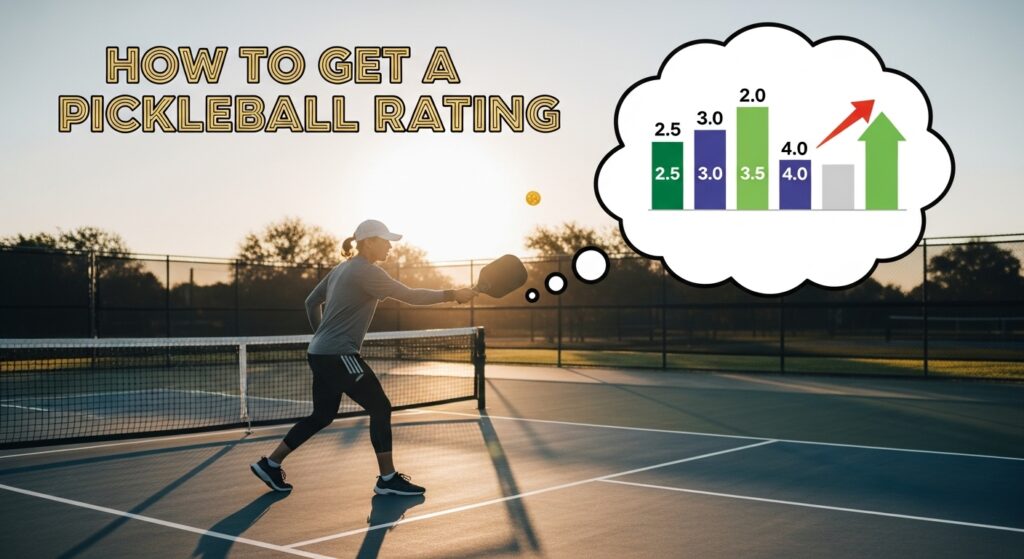
How Pickleball Rankings Work
While a “rating” defines your skill level, a “ranking” determines your standing compared to other players, typically within a specific tour or region. Rankings are earned by accumulating points through tournament performance.
Amateur vs. Professional Rankings
In the amateur world, rankings are primarily used to seed players in tournaments. A higher-ranked player will be given a more favorable position in the tournament bracket, typically by being matched against lower-ranked players in the early rounds. These rankings are based on points earned at previous events.
For professional players, rankings are everything. They determine:
- Entry into tournaments (especially those with limited spots).
- Seeding within the draw.
- Qualification for championship events.
- Bargaining power for sponsorships.
The Tournament Points System
Professional tours like the PPA and APP use a points-based system. Players earn points based on how far they advance in a tournament. Major tournaments, often called “Grand Slams” or “Majors,” are worth more points than standard events.
For example, a player might earn:
- 2000 points for winning a Major.
- 1500 points for winning a standard Tour Stop.
- 1000 points for winning a smaller event.
- Fewer points are awarded for finishing as a runner-up, semifinalist, and so on.
A player’s ranking is typically based on their best results over a rolling 52-week period. This system rewards both excellence and consistency. To maintain a high ranking, players must consistently perform well throughout the year.
The Professional Pickleball Scene
The pickleball professional scene has grown from a niche community to a multi-million dollar industry in just a few years. It’s an exciting landscape characterized by competing tours, rising stars, and increasing investment.
Overview of Major Tours
Three main entities dominate professional pickleball: the PPA Tour, the APP Tour, and Major League Pickleball (MLP).
PPA Tour (Carvana PPA Tour)
The PPA Tour is widely considered the premier tour, attracting the very top talent with exclusive contracts. The pickleball PPA tour explained simply is this: it’s where you’ll find the highest level of competition and the biggest prize money. PPA pros are typically barred from playing in competing tour events. Key players like Ben Johns and Anna Leigh Waters, who dominate the pickleball pro rankings 2025, play exclusively on the PPA Tour.
APP Tour (Association of Pickleball Professionals)
The APP Tour has an “open” philosophy, meaning players are not required to sign exclusive contracts. This makes it a vital platform for up-and-coming professionals, senior pros, and international players looking to make a name for themselves. The APP Tour hosts events across the US and has a growing international presence.
Major League Pickleball (MLP)
MLP introduced a unique, team-based, co-ed format that has revolutionized how fans and players experience professional pickleball. It features a fast-paced, energetic atmosphere with team owners that include celebrities and high-profile athletes like Tom Brady, LeBron James, and Eva Longoria.
Players are drafted onto teams and compete in events throughout the year, culminating in a championship. The format emphasizes teamwork and strategy in a way that traditional doubles play does not.
In 2024, the PPA Tour and MLP completed a merger, consolidating the top players under one umbrella to create a unified professional calendar.
How Much Do Pro Pickleball Players Make?
The question of pro pickleball salaries is a hot topic. While it’s not at the level of tennis or golf yet, the earning potential for top players is significant and growing rapidly. A pro’s income comes from three main sources.
Tournament Prize Money
Prize money is the most direct form of income. The total prize pool for a major PPA Tour event can exceed $300,000, with the winners of the pro singles, doubles, and mixed doubles brackets taking home the largest shares. A top player who consistently wins or reaches the finals at major events can earn several hundred thousand dollars per year in prize money alone. For example, the top male and female players can earn over $250,000 in a single season from winnings.
Sponsorships and Endorsements
This is where the elite players make the most money. How much pickleball players make from sponsorships can far exceed their on-court winnings. These deals include:
- Paddle Sponsors: Every pro player has a paddle sponsor. These deals often include a base salary plus bonuses for tournament wins. Top players can command six-figure contracts from major brands like JOOLA, Selkirk, and Paddletek.
- Apparel and Shoe Deals: Similar to paddle deals, players sign with athletic wear companies.
- Non-Endemic Sponsors: As the sport’s visibility grows, brands outside of pickleball (like wellness companies, financial services, and automotive brands) are beginning to sponsor top players, indicating the sport’s mainstream appeal.
Coaching, Clinics, and Other Income Streams
Beyond prize money and sponsorships, pros have other ways to monetize their expertise. Many run coaching clinics when they are not competing, which can be very lucrative. Some have popular YouTube channels or social media followings that generate advertising revenue. Others may receive appearance fees for participating in corporate or charity events.
Combining all these sources, the very top-tier players, like Ben Johns and Anna Leigh Waters, are estimated to earn well over $1 million annually, with some reports suggesting figures closer to $2 million. A player ranked in the top 20 can likely earn a comfortable six-figure income, while players outside the top 50 may struggle to break even after accounting for travel and expenses.
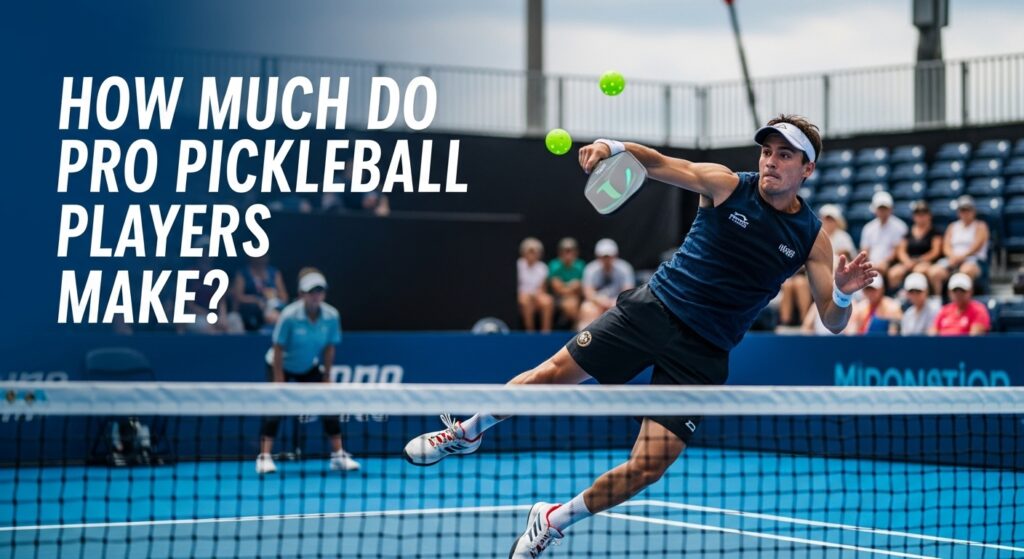
How to Run a Pickleball Tournament
Organizing a pickleball tournament can be a rewarding way to bring your local community together. Whether it’s a small, friendly event or a larger, more competitive one, the key is planning.
1. Choose a Format
The tournament format determines how players advance. The most common are:
- Round Robin: Every team plays against every other team in their group. This format guarantees a lot of play for everyone, making it great for community events.
- Single Elimination: If you lose, you’re out. This is a fast-paced, high-stakes format.
- Double Elimination: The most common format for competitive tournaments. If you lose once, you drop to a “consolation” bracket where you still have a chance to play for a medal. You are eliminated after your second loss.
- Ladder: Players challenge each other to move up and down a “ladder” or ranking over a period of weeks or months.
2. Set the Rules and Scoring Format
Decide on the specifics. Will games be to 11, 15, or 21? Will they be win-by-1 or win-by-2? Will medal matches be best 2 out of 3 games? Ensure you clearly communicate all rules to participants before the event starts. For official events, follow the USA Pickleball rulebook.
3. Use Pickleball Tournament Software
Managing brackets, scores, and court assignments manually is a nightmare. Using pickleball tournament software is a must for any event with more than a few teams. Platforms like Pickleball Brackets, Pickleball Den, and DUPR’s event management tools can handle:
- Player registration and payments.
- Creating brackets and seeding players.
- Scheduling matches and assigning courts.
- Live score updates that players can see on their phones.
- Communicating with participants via text or email.
This software automates the most difficult parts of running an event, allowing you to focus on creating a great experience for the players.
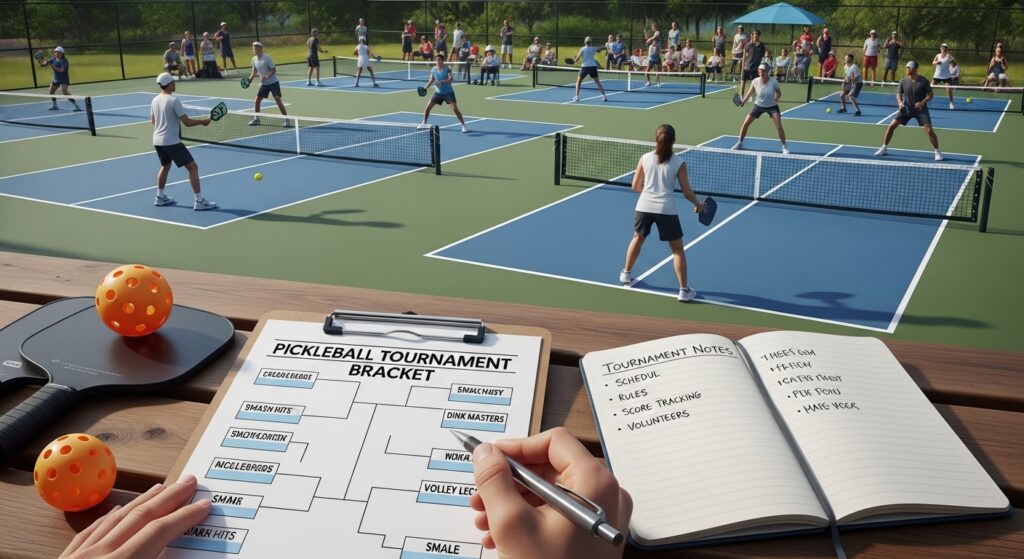
4. Organize Logistics
Don’t forget the details:
- Courts: Secure enough courts for the number of participants.
- Volunteers: You’ll need help with check-in, score reporting, and answering questions.
- Equipment: Have plenty of high-quality pickleballs on hand.
- Amenities: Consider providing water, snacks, and shade for players.
Whether you’re organizing a pickleball tournament in the UK or a local league in the US, the principles are the same: plan ahead, communicate clearly, and use technology to make your job easier.
Also Read The Rise of Pickleball: How It Became the Fastest-Growing Sport ?
FAQs
What’s the difference between DUPR and UTPR?
DUPR is a universal rating for all play (recreational and tournament), updates after every match, and is ageless and genderless. UTPR is specifically for USA Pickleball-sanctioned tournament play and updates less frequently.
How do beginners get a rating?
The easiest way for a beginner to get a rating is to download the DUPR app and have a player with an existing DUPR log a match against them. After a few games, an initial rating will be established.
What’s a good DUPR score?
- Below 3.0: Beginner
- 3.0 – 3.9: Intermediate Player
- 4.0 – 4.4: Advanced Player
- 4.5 – 5.0: Expert/Near-Pro Level Player
- 5.0+: Pro-Level Player
A “good” score is relative to your goals. For many, being a solid 4.0 player is a great achievement.
Who is the #1 ranked pickleball player?
Rankings change frequently, but as of late 2024 and heading into 2025, Ben Johns is consistently the #1 ranked male player across multiple disciplines, and Anna Leigh Waters is the dominant #1 ranked female player. You can check the official PPA Tour website for the latest pickleball player rankings.
How much can a pro pickleball player earn in a year?
The top 1-2 players in the world can earn over $1,000,000 per year from prize money, sponsorships, and appearance fees. Top 10 players can earn $250,000 to $500,000+, while a top 25 pro might earn a solid six-figure income.
Conclusion
The world of pickleball ratings, rankings, and professional play is more accessible than ever. Systems like DUPR have democratized skill assessment, allowing every player—from the weekend warrior to the aspiring pro—to track their progress and find competitive matches. The growth of the professional tours provides a thrilling spectacle and a legitimate career path for the sport’s most talented athletes.
Whether you’re stepping onto the court for the first time or you’re a seasoned tournament veteran, understanding this ecosystem enhances your connection to the game. So get your rating, follow the pros, and maybe even organize a tournament of your own. The future of pickleball is bright, and there’s a place for everyone in it.
